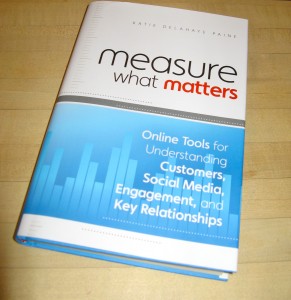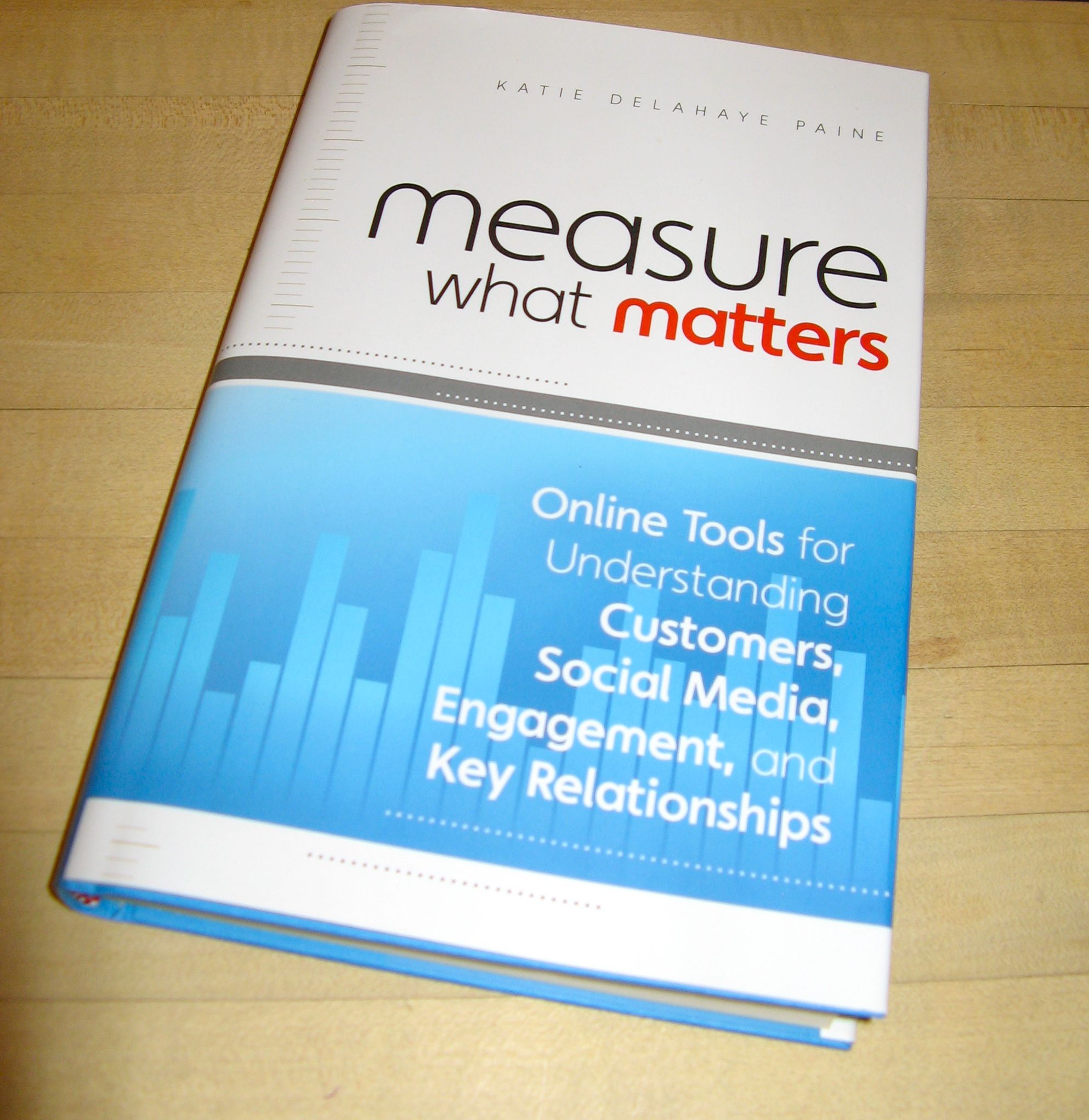Measure what matters. You’ve probably heard the phrase more than once, because it’s one of those admonitions that resonate as common sense. But as the talk turns to analytics, scorecards, metrics, KPIs and such in the day-to-day world of implementing marketing plans and PR campaigns, you suddenly realize it can be a lot harder to act on that wisdom than it is to repeat it. Here are three new resources that I’m finding helpful.
Katie Paine’s new book
Measure What Matters: Online Tools for Understanding Customers, Social Media, Engagement, and Key Relationships is the mouthful of a title for the latest book from Katie Paine, a long-time advocate and provider of rigorous public relations measurement approaches. The book delivers on its title.  Unlike many of her counterparts, Katie goes beyond broad “should” platitudes into step-by-step recommendations that include both the pricey tools beyond the reach of many businesses, as well as free or low-priced alternatives. There is a healthy emphasis on finding the right tool for your situation and most importantly, on not being seduced into thinking there is one perfect tool, one perfect number, one perfect path to evaluating and improving your relationship communication activities.
Unlike many of her counterparts, Katie goes beyond broad “should” platitudes into step-by-step recommendations that include both the pricey tools beyond the reach of many businesses, as well as free or low-priced alternatives. There is a healthy emphasis on finding the right tool for your situation and most importantly, on not being seduced into thinking there is one perfect tool, one perfect number, one perfect path to evaluating and improving your relationship communication activities.
Information junkie that I am, I particularly valued things you don’t find in every other book on the subject:
- A comprehensive glossary of terms and how they vary by discipline
- Measurement resources in the appendices, including the Grunig Relationship Survey tool
- How to measure influencers and thought leadership, including how to build a list of the top influencers in your market
- An unusual and practical chapter on how to measure relationships with salespeople, channel partners, and franchisees
- Measuring the impact of events, sponsorships, and speaking engagements, presented as a practical process
As complete and practical as Katie Paine’s book is, I began to feel Excel® fatigue just reading about developing the detailed spreadsheets that were recommended for comprehensive measurement programs. (I suggest anyone who specializes in selling measurement services would be well advised to give a copy of this book to all prospects. Any company that can afford your services will gladly pay once they see the work involved.)
Two New Social Media Measurement Tools
So in comparison, the two other new resources I have been enjoying are narrow windows on measurement. Both focus solely on making it easier to measure the effects of your social media efforts.
Facebook Insight
Facebook announced significant improvements to their Insight analytics. Earlier versions were quite weak, especially for advertisers accustomed to the wealth of information provided by Google AdWords and its kin. Now Facebook Insights allows page administrators to view data in real time and in detail by plugin, including the new Comments feature plugin that is driving traffic so nicely. Site owners can also see the number of interactions taking place by specific demographics — by age group, gender, language or country for those using these plugins on their sites. Both Mashable and Website Proprovide good introductions and Facebook Insight graphs for their pages.
HootSuite Analytics
We use a combination of HootSuite and Vocus to help us manage and measure our social media efforts for clients. HootSuite allows us to work collaboratively with client teams across their multiple social media accounts, so the significant upgrade to their social analytic reporting capabilities is very welcome. Its strength is that in one Dashboard we can review data together on each Twitter account, Facebook Page Insights, Google Website Analytics, and business blog.
Blogger Danny Brown provided a concise overview and 6-minute video of HootSuite’s expanded reporting capabilities.
This post contains a video. If you can’t see it displayed properly in your feed, you can watch it directly here.
Measure What Matters
These three new resources can help you use numbers to get closer to your goals. Analytics, scorecards, metrics, and KPIs are all designed for that purpose, but I find the tools can often get in the way as client teams strive for continuous improvement for their business operations, including marketing communications. Look for more in the coming months on what processes and tools can best help you share and track content and assets, and what resources you need in place at every level. (Subscribe above so you won’t miss out.) Meanwhile go forth, and measure what matters.



